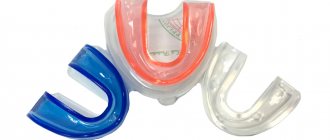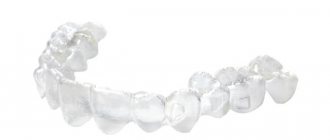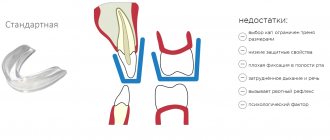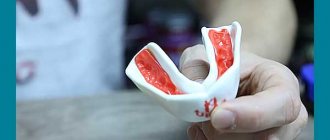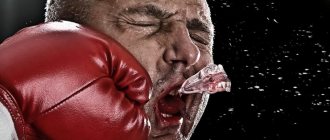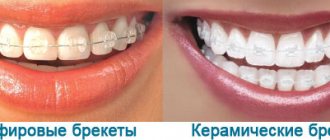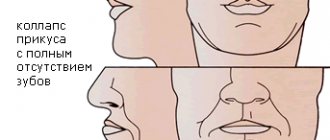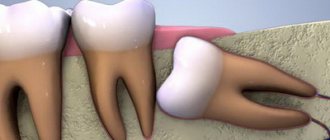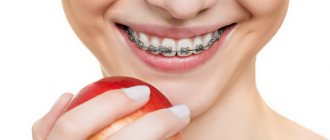1053
The first sports mouth guard was developed to protect boxers. Several people who worked on it simultaneously at the end of the 19th and beginning of the 20th century lay claim to the laurels of its inventor.
However, the “father” of sports mouthguards is considered to be the American Liliquist, who in 1948 in the ADA magazine described the technology for making a structure made of acrylic.
Today it is recommended to use mouth guards in 29 sports. In some of them - boxing, American football, combat sports, etc. - the use of intraoral protection is mandatory.
General presentation and purpose
A sports mouth guard is an elastic material that is worn over the teeth to prevent injuries to the orofacial area during sports and competitions.
Most mouthguards are placed on the upper row of teeth. Interaction with the lower jaw depends on their type. They can only slightly cover the lower teeth or cover them completely.
At different times, different materials were used for manufacturing. The very first samples were made from natural rubber. Subsequently, acrylic and silicone began to be used. Most modern high-quality sports pads for professionals are made from vinyl acetate and ethyl polymers.
The main purpose of the products is to protect the orofacial area (teeth, tongue, mucous membranes of the oral cavity, jaws) and the brain from injury. The protective function is realized by separating the teeth and soft tissues, as well as the dentition from each other, with an elastic gasket , which absorbs the energy of impacts and prevents them from being injured.
Design features of the Air Align mouth guard and bite treatment tactics.
Visit here to learn more about VSD aligners.
At this address https://www.vash-dentist.ru/ortodontiya/kapyi/elayneryi-invisalign-teen.html everything about Invisalign teen aligners.
Color
The color of the mouthguard is not regulated by sports organizations. Manufacturers produce a variety of options. Not only models of different colors are sold - there are mouth guards with drawings and inscriptions.
Manufacturers offer products with various flavor interpretations, with mint flavor being the most popular. This plant is an antiseptic; it not only serves as protection against pathogenic bacteria, but also freshens breath.
Coaches recommend that their players choose mouthguards of light colors, without any smell or taste, so that they do not remind anyone of their presence and do not distract the athletes during a fight or game.
Varieties
The designs of modern protective devices are extremely diverse. They have different designs, volumes, structures and wall thicknesses. Custom mouthguards may contain inscriptions or designs on the visible front that indicate they belong to a specific athlete.
Depending on the type of sport, the mouth guard may have additional functional elements and different forms of contact with the lower and upper dentition.
According to their relationship with the jaws, mouth guards are:
- bimaxillary (bilateral, double);
- single-jawed (one-sided, single).
The first category is devices consisting of two onlays for the upper and lower jaws, connected along the occlusal surfaces. Single-sided mouthguards consist of a single guard for the upper jaw, which has a small plate at the front to protect the lower teeth.
Single-jaw models make it easier to breathe, but they protect your teeth worse. Double-sided devices, which provide more protection, may make breathing difficult despite the openings at the front.
According to manufacturing technology, products are divided into the following types:
- Templates (standard, cast, plastic).
- Thermoplastic (“boiled”, adaptation).
- Individual (dental).
In addition, protective devices can be single-layer or multi-layer. The latter types consist of 2-3 layers of varying elasticity. The hard layer acts as a frame, while the soft layers absorb and absorb impact energy.
Template
Standard models are manufactured industrially (in series) from inexpensive material - silicone or rubber. They have several sizes, allowing you to select them for a specific jaw.
The advantages of template products include low cost and ease of use. They are completely ready for use, do not require any additional manipulations - buy, put on, and you can start practicing.
The list of disadvantages of standard models is much wider. Most of them are a consequence of the fact that template-made devices do not take into account the individual characteristics of the oral cavity of a particular user.
Standard intraoral appliances:
- do not hold well in the mouth, are held mainly by clenching the teeth;
- does not protect against injury well enough;
- interfere with breathing and speech;
- may cause a gag reflex;
- interfere with drinking;
- distract the athlete’s attention from the current sports situation;
- short-lived.
Template models are not recommended for professional use in sports where physical contact with an opponent is allowed.
Thermoplastic
Thermoplastic products are sold in stores and also include standard models. But they have one important feature that gives them a significant advantage over template types. They are made from a thermoplastic material that can be transformed to fit the jaw of a specific user through a special procedure called adaptation or “boiling.”
Adaptation consists of heating the product in hot water to a thermoplastic state and biting it with the teeth. Thanks to the self-polymerization of the material, tooth imprints retain their shape, allowing the product to be securely fixed on the jaws.
It is obvious that the adapted thermoplastic model is much stronger than the template one, is fixed on the teeth, and more effectively protects the athlete from injury.
The highest quality are multilayer thermoplastic mouthguards. They hold their shape well thanks to the hard middle layer, while at the same time effectively absorbing impacts with elastic, outer structures.
With all the advantages, thermoplastic linings also have disadvantages. In particular, when they are compressed by the teeth during molding, the bite may be disrupted , and in the future the polymerized product will set the jaws in the wrong position. In this case, it is advisable to re-adapt. The properties of the polymers used allow this.
And yet, thanks to their relatively high quality and reasonable price, thermoplastic mouthguards are a good option for amateur athletes. Therefore, they are the most common intraoral protective devices compared to template and individual models.
Individual
Individual (dental) mouthguards are made taking into account the structure of the dental apparatus of a particular athlete. All their elements perfectly match the morphology of teeth and mucous membranes.
The athlete always has a choice - to make his intraoral protection single-layer or multi-layer. The first one is cheaper, but has serious disadvantages. Due to poor filling of the dental cervical areas, single-layer structures do not provide reliable fixation on the teeth.
In addition, one plate is not enough to ensure the mechanical strength of products, especially on the cutting edges of the front teeth. Intensive use leads to rapid thinning of products in these places and the need for replacement.
Multilayer mouthguards do not have such disadvantages. The material fills all undercuts and firmly covers the dentition. Significant wall thickness, the presence of rigid layers, various additional elements, high characteristics of the source material - all this ensures good functionality and long service life of complex multilayer structures.
In addition, individual mouth guards take into account the patient’s dental status, the characteristics of his bite and the position of the teeth. Wearing braces is also not an obstacle to their use.
Of course, making an individual multi-layer mouth guard requires time and financial expenses, but the result is more than worth the time and money spent. Especially when it comes to professional sports.
Price
One of the determining factors when choosing protective pads is their cost. And here consumers can expect complete variety:
- For beginner fighters, a cast or templated one-sided silicone design, the cost of which is in the range of 450-500 rubles, is more suitable.
- A two-layer thermoplastic construction with a higher level of protection can be purchased for 1600-1800 rubles.
- The cost of the device for professional athletes can reach up to 5 thousand rubles.
Manufacturing technology
Individual sports mouthguards are manufactured in dental clinics that have all the necessary equipment and qualified personnel.
At the first visit, the client is examined and discussed with him the type, color and symbolism of the mouth guard. It is advisable that the oral cavity be sanitized and all diseased teeth be treated and filled.
The manufacturing technology, especially in its initial stage, is in many ways similar to the production of orthodontic structures, in particular aligners, and includes the following steps:
- Taking impressions from the upper and lower jaw.
- Making a plaster model of the dentition using a cast.
- Molding a mouth guard using a plaster model.
- Finishing processing. Removing excess material, cleaning the product with a grinding tool.
- Trying on the finished product, modification if necessary, and delivery to the patient with care recommendations.
Features of product molding
Previously, acrylic polymers and latex materials were used as materials for sports mouthguards, the properties of which did not fully meet the conditions of their use.
Thermoplastic vinyl acetate and ethyl polymers have proven to be good alternatives. In addition to suitable mechanical and physical characteristics, they have complete biocompatibility with human tissue, resistance to acidic environments, and are tasteless and odorless.
The initial form of the material is colorless or colored polymer plates of different hardness, 2-4 mm thick. They can be marked with information about their technological properties - melting temperature, holding time during polymerization, etc.
The molding of the trays is carried out in a vacuum former. The principle of operation of the device is that a heated polymer plate under the influence of vacuum is attracted to a plaster mold, exactly repeating its configuration.
In the manufacture of multilayer structures, several plates are connected and formed, rigid in the middle, elastic on the outside.
On average, the production of individual intraoral protection takes 1-1.5 weeks. This will require at least two visits to the doctor.
Choosing a mouthguard depending on age
There are models designed specifically for adults and for children. Features of choosing a mouthguard taking into account the age and physical characteristics of the athlete:
- Children's mouth guards are recommended for use in children under 10 years of age with a height of no more than 140 cm;
- For athletes who have reached the age of 11 or have a height of 140 cm, buy adult models.
If the mouth guard is too big, you can reduce it a little. Most adult models are adjusted to the individual parameters of the athlete - a child or an adult with a non-standard jaw. The mouthguard is trimmed to the required size and, if necessary, re-welded.
Product advantages
Any sports mouthguards, regardless of their type and properties, increase the safety of the athlete. The most complete list of advantages has individual multi-layer mouth guards, characterized by the following properties:
- Maximum degree of protection. The multi-layer design and precise fit of the mouthguard to the teeth allows it not only to withstand high dynamic loads, but also to distribute them evenly across the dentition.
- Wearing comfort. Precisely fitted individual designs ensure easy, free breathing and swallowing (you can drink drinks without removing them), clear speech, and no nausea.
- Hypoallergenicity and biocompatibility with oral tissues of the materials from which modern individual intraoral protective structures are made.
- Improving athletic performance by increasing concentration, reaction and speed. Individual mouth guards do not require constant monitoring; they are securely fixed both with the mouth closed and open.
- Long service life thanks to the use of quality materials.
A properly made individual mouthguard has a beneficial effect even on those physiological parameters of a person that, it would seem, are not directly related to the dentofacial apparatus.
Thus, studies have shown that well-fitted intraoral protection relieves the neck and back muscles, increases the stability and coordination of the athlete, thereby reducing the risk of injury to the knee joints.
The only disadvantages of the product include:
- at least two visits to the doctor;
- the need to wait about a week until the product is manufactured;
- relatively high cost.
The secret to the popularity of the Clearcorrect mouth guard and product characteristics.
In this publication we will talk about the purpose of splints in dentistry.
Here https://www.vash-dentist.ru/ortodontiya/kapyi/elayneryi-flexiligner.html you will find objective reviews about Flexiligner aligners.
Disadvantages of custom mouth guards
· Price. This is the most expensive type of mouthguards, since they are made individually using computer modeling. During the production process, high-quality biocompatible material that does not cause allergies is used.
· Long production time. Unlike standard mouthguards, which can be put on right away, a custom design takes some time to create.
Care instructions
The service life depends on the material from which the pad is made, design, intensity of use and, of course, care for it. It is impossible to name the exact operating time, but in general it is believed to be about 3 years.
Proper care can extend the life of the product. It is simple and consists of following a few rules:
- Should only be used when playing sports.
- It should be stored in a special, ventilated (to get rid of odor) container.
- You must refrain from the desire to chew the pliable elastic structure.
- After each use, rinse in running water to remove bacterial deposits.
- Brush occasionally with a toothbrush and toothpaste (some experts recommend doing this after each use).
- Do not expose the polymer product to elevated temperatures or direct sunlight.
- Periodically inspect for damage and bites. If any are found, the device must be replaced.
In general, all the details of caring for mouth guards are outlined in the instructions that come with them.
In the video, a specialist will tell you in more detail about the types of sports mouth guards.
What is it used for?
Indications:
- crowding of teeth, which literally “crawl” onto each other and/or grow outside the dentition;
- large gaps between teeth – diastemas and trema;
- deep bite;
- gum disease;
- increased tooth wear;
- dysfunction and pain in the temporomandibular joints (TMJ);
- dysfunction of the musculo-ligamentous apparatus of the face;
- bruxism;
- preparatory stage before implantation;
- improper functioning of the chewing apparatus.
Reviews
The abundance of types of sports mouthguards makes their choice difficult, especially for those users who purchase them for the first time.
If you use/have used thermoplastic or custom mouthguards, please share your impressions of them. Any details may be of interest - ease of wearing, cost, service life, etc. You can leave a comment at the bottom of this page.
If you find an error, please select a piece of text and press Ctrl+Enter.
Tags mouth guards
Did you like the article? stay tuned
Previous article
Modern effective methods for reconstructing crowded teeth
Next article
Pros and cons of installing an implant immediately after tooth extraction
What other requirements apply to good mouthguards?
- color. Oddly enough, it matters here. The main thing is that it is light and not red. All this is done so that dangerous damage can be noticed in time;
- absence of smell, taste, aroma, etc. These characteristics must be at an absolutely zero level, because over time they begin to irritate the owner, or even cause allergic reactions;
- The pad should not be felt in your mouth at all. Indeed: good mouth guards do not cause any pain, do not cause discomfort, do not interfere with speaking, breathing, or hinder movements;
- You should choose a rubber according to the sport you are playing. Wrestling mouthguards will be uncomfortable for hockey players and vice versa. Mouthguards differ even by gender: male and female.
Design features
Here we can distinguish three main types, we will arrange them in order of increasing quality and characteristics.
Standard (cast)
These are universal factory mouthguards that do not have outstanding characteristics. They are made of plastic (there are also silicone versions), inexpensive, and quite suitable for beginner amateur athletes. The main disadvantages are poor fixation, standard shape, without the possibility of changes, and insufficient thickness.
Thermocaps (thermoplastic)
This type of mouth guard is a kind of semi-finished product - the product requires individual adjustment, which is done at home (“brewed” and conveys the structural features of the teeth, jaw, and bite). They can have a multilayer structure (a combination of materials is used) and have good fixation.
Custom mouth guards
They are used by professional athletes and are made to order from the dentist (an individual impression of the jaw and bite is made). These mouthguards provide maximum protection and have shock-absorbing properties. Modern technologies make it possible to produce neuromuscular mouthguards that are able to respond to changes in muscle forces (involuntary clench/unclench the jaw) and find the optimal position.
Treatment using aligners
Corrective therapy in our dental departments is carried out according to the following algorithm:
- Visit to an orthodontist by appointment. Important: treatment is possible only with a completely sanitized oral cavity;
- visual and hardware diagnostics in order to identify indications or contraindications for treatment with mouth guards;
- if indicated, the doctor performs a 3-D scan of both jaws of the patient to subsequently create a computer model of them, and also draws up a detailed correction plan;
- production of a set of mouth guards in America at the Aling Technology plant according to individual patient data;
- sending finished aligners to our clinic;
- starting a course of corrective therapy. The doctor explains the rules of wearing and care, sets the date for the next visit;
- Every 1 – 2 weeks the patient himself changes the mouthguard to the next one from the kit in numbering order.
Contraindications
Orthopedic mouth guards are useless for skeletal defects of the jaw bones and the presence of impacted teeth. They are not given to patients with TMJ pathologies, destructive damage to alveolar tissue and severe mental disorders.
Important!
Absolute contraindications include malignant tumors in the oral cavity, tuberculosis, cardiovascular pathologies in the stage of decompensation, autoimmune disorders and diseases in which bone density decreases.
Dental mouthguards are not used for severe diabetes mellitus, serious dysfunction of the thyroid gland, pituitary gland and adrenal glands. They are also contraindicated in cases of diagnosed lymphogranulomatosis, thalassemia, leukemia, hemolytic anemia and HIV.
Night guard for straightening teeth
Imagine that there is a design for correcting your bite, which you only need to wear at night. It does not require any additional care other than simple cleaning once a day. Thus, it does not interfere with work, communication, eating and does not cause discomfort. Intrigued? We hasten to disappoint you. Unfortunately, nothing like this has yet been invented. But it’s hard not to agree that if a night guard existed, it would, without a doubt, be considered the most convenient to use and enjoy overwhelming success. However, correction of dental anomalies is a complex process that involves exposure to teeth over a certain period of time, and wearing aligners for less than 20 hours a day, unfortunately, will not be effective.
However, among the arsenal of orthodontic devices there are still devices that need to be worn only at night. They are called removable retainers and are used to consolidate the results after treatment with braces. The teeth do not immediately “get used” to the new position, so they often strive to return to their original position. Retainers prevent them from doing this and help keep their teeth perfectly straight.
How long should you wear the aligners and how often should you change them?
Dental mouth guards are manufactured within a few weeks and are given to the patient in a labeled form. According to the legend, a person changes them independently every 3 weeks or more often. Before replacing, take a short break.
Bite correction takes from a year to two, the duration of treatment depends on the complexity of the case. Sometimes a few months are enough, but not less than six months. It is recommended to visit your doctor monthly to evaluate the results and make possible adjustments.
Popular brands
Transparent aligners for teeth straightening are produced by several manufacturers. The most famous and popular are Invisalign, Star Smile and 3D Smile.
- Invisalign was the first to enter the orthodontic device market and gained recognition thanks to the use of modern technology. The entire process of creating aligners is simulated by the Clin Check computer program from Align Technologies.
- The Star Smile brand produces domestic products that are not inferior in quality to their foreign counterparts, but are more affordable. The company sells its products not only in Russia, but also exports them to the USA, Canada, New Zealand, UAE, Australia, neighboring countries, etc.
- 3D Smile is a member of the Skolkovo innovation center, which in just a few years has become one of the top three startups according to Forbes. The company presents its products as a system that combines the advantages of previous generations of braces and aligners with super-precise 3D modeling and printing technologies.
